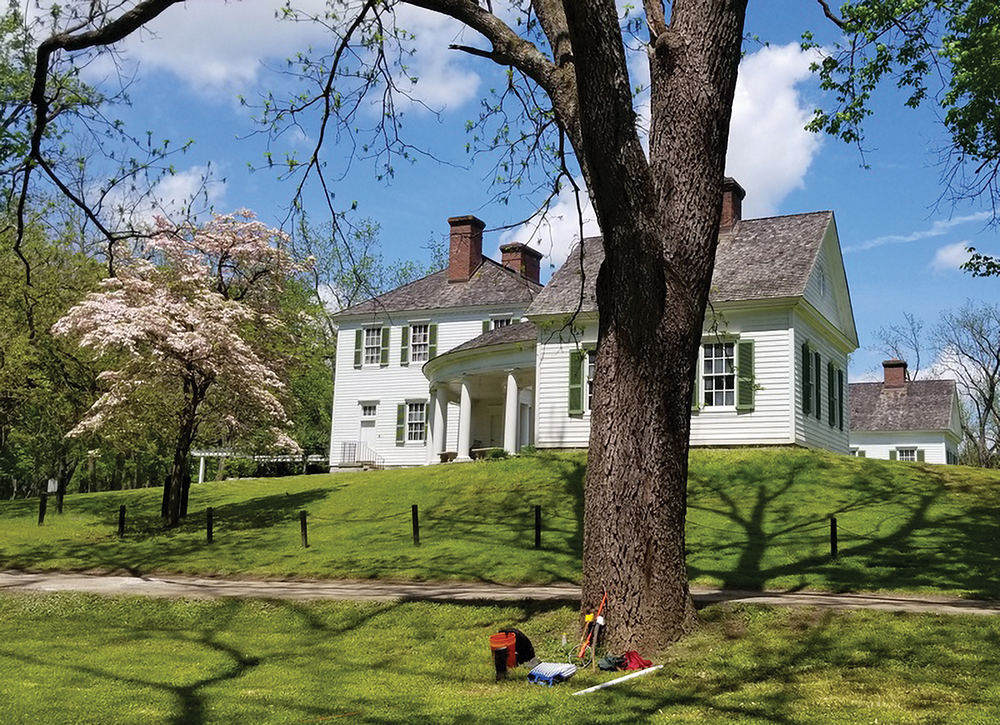
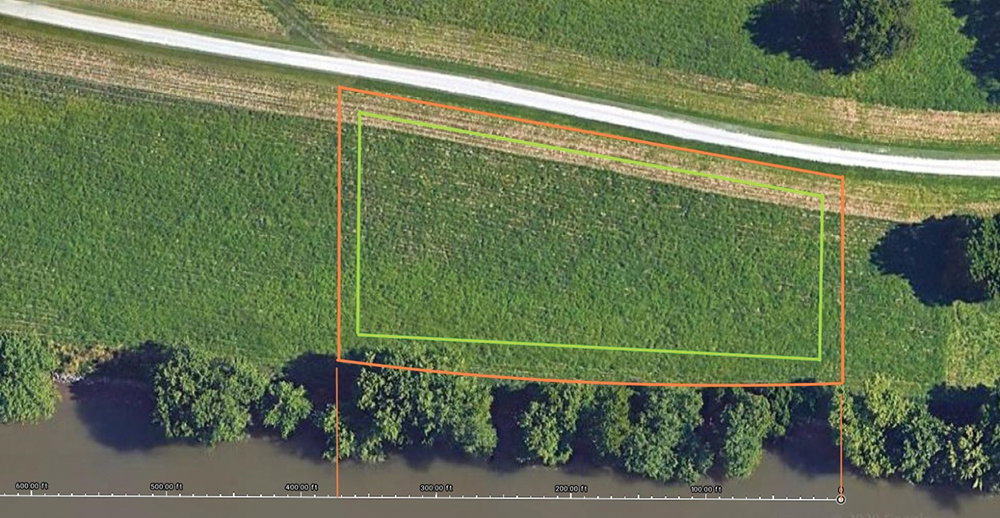

In the autumn of 2020, a group of dedicated enthusiasts established an experimental planting of black walnuts at Blennerhassett Island Historic State Park. Blennerhassett Park is a special place for existing and wannabe walnut growers because of its rare and impressive 88-year-old black walnut plantation planted on 2.4 acres adjacent to the historic Blennerhassett mansion (Figure 1). With a successful new planting described below, Blennerhassett will be the Mecca of black walnut growers. Everybody will have to see it once in their lifetime. This article describes the project and some early successes and challenges.
The concept guiding the Blennerhassett experimental planting follows the general method described on the webpage titled “Growing Top Quality Veneer Black Walnut on the First Try (You Only Get One Try).” The basic idea is that trainer trees of various species growing next to black walnut crop trees grow in a way that encourages rapid upward growth and quick side shading of the walnuts’ tree trunks; this side shading causes fast “natural pruning” of side branches. Walnut growers may plant the trainer trees a year or more before planting the black walnuts to generate the right amount of side shade.
When we approached West Virginia’s Blennerhassett State Park management with the proposition of hosting the experimental planting, the idea was quickly and graciously approved. They helped us choose a site ideal for planting and their educational guided tours (Figure 2).
The objective of this experimental project is twofold. The first objective is to answer the question: Is the resulting improved timber stem quality economically worth the value of the time lost due to the delayed planting of the walnuts among the trainer trees? The second objective is to investigate and demonstrate how to grow our most valuable native woodland timber product reliably—veneer-quality black walnut.
Background
Black walnut trees cannot grow in the shade—they are shade-intolerant. Not only are black walnut trees shade intolerant, but also it is the same for every one of their branches. The essence of starting veneer-quality trees like the one in (Figure 3) is to heavily shade the trees’ lower branches at a very early age. Such heavy early shading causes the side branches to fail and fall off while still small in diameter. At the same time, the tops of the trees need full sunlight so stem volume growth can proceed, ideally as if they were growing with their throttle wide open.
Black walnuts’ leafy crowns do not produce sufficient shade to clear their lower branches soon enough to make veneer-quality wood. Black walnut monoculture plantings require manual pruning to produce veneer quality. A tree like the one in Figure 3 is not attainable in purely monoculture plantings, barring an exceptional amount of labor to prune off side branches.
There is a whole list of requirements for trainer species that can provide the amount and arrangement of shading needed. First, the understory light level in a planting needs to be very low. The vertical growth rate of trainer trees must challenge the typical vertical growth of the black walnuts but not seriously overtop them. Conifers (cone-bearing trees) generally have crowns with a conical shape that provide the ideal shading arrangement with shade below and open sky above. The trainer species must grow well on a good black walnut site and be somewhat resistant to the juglone toxin that walnut produces in the soil. The site must be good for both the trainer and the black walnut species. So far, in previous trials, white pine and bald cypress have shown promising results as black walnut trainers. Regardless of the species used, trainer seedlings must be in place and producing shade as the black walnut plants emerge.
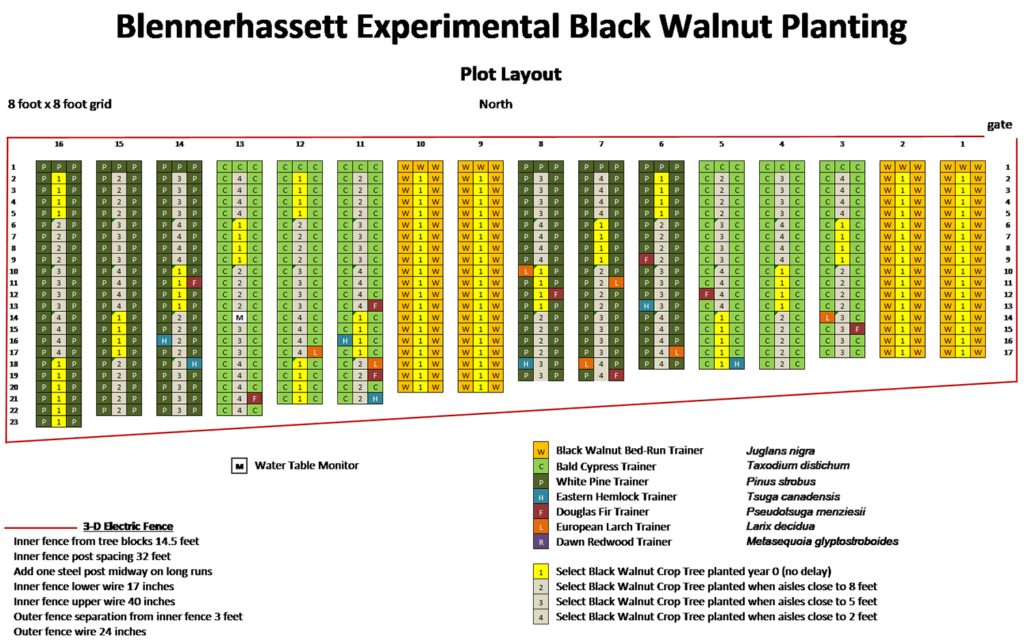
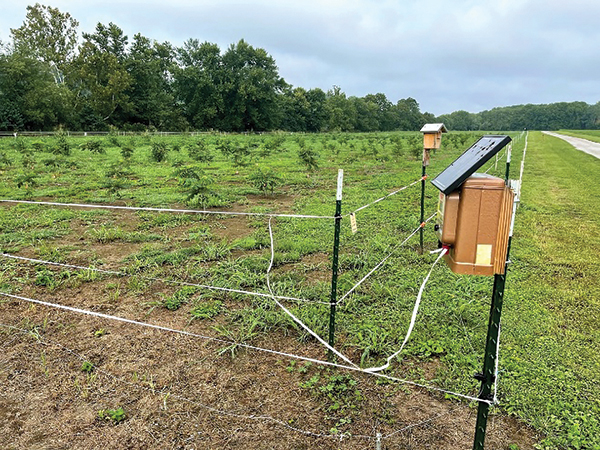
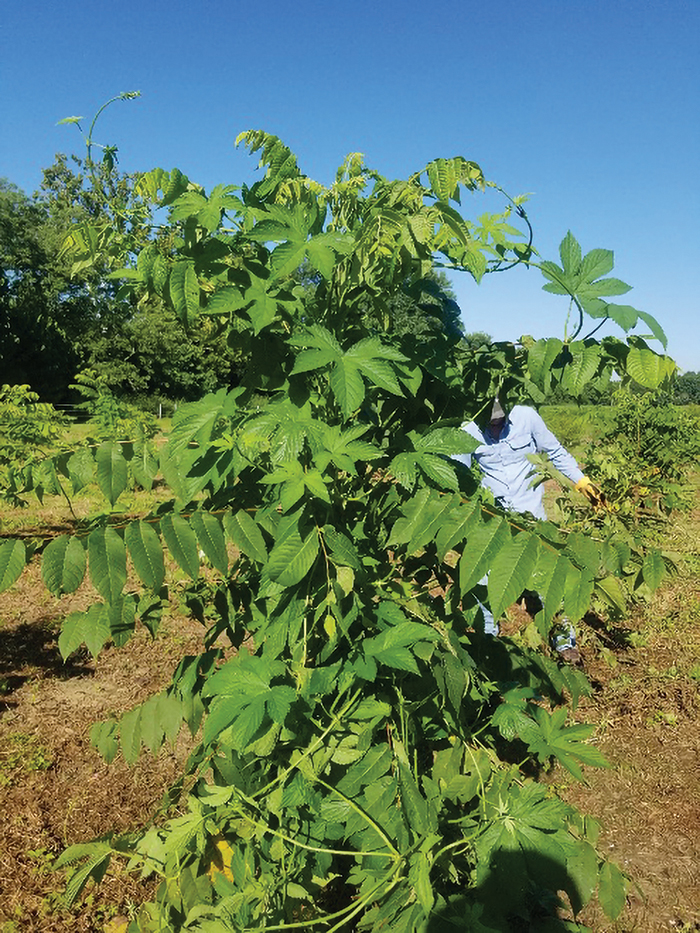
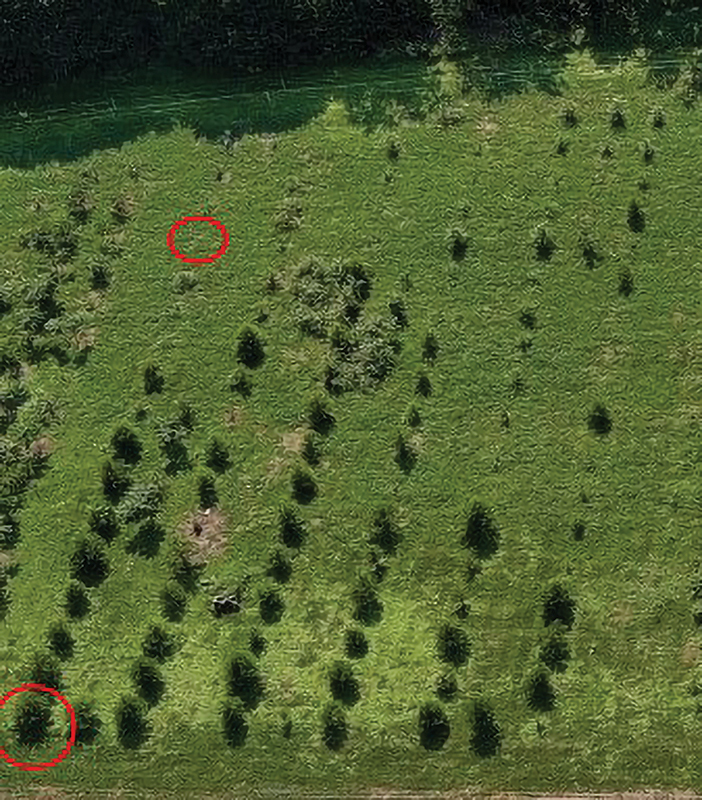
Methods
Our curiosity about discovering the fastest way to grow the highest quality black walnut wood led us to hypothesize that the improved stem quality resulting from aggressive early trainer shading and delayed black walnut planting would be greater than the value lost due to the delayed planting. To evaluate the economic effects of using trainer trees and delayed black walnut planting on black walnut stem value, we established the experimental planting to investigate two primary factors: 1) trainer tree species and 2) delay time in planting black walnuts following the planting of trainer trees.
The general spacing of the plantation is an 8 ft x 8 ft grid. Trainers are planted in year one at 8-foot spacing within rows 16 feet apart. The partially randomized plot layout shown in Figure 4 includes monoculture and no-delay planting control blocks. Weed control is performed as needed during the early years of growth.
Delayed plantings include:
- Immediate planting (control with no delay; when alleyways are 16 feet wide).
- Planting when alleyways are 8 feet wide.
- Planting when alleyways are 5 feet wide.
- Planting when alleyways are 2 feet wide.
This investigation’s initial trainer tree species include black walnut, bald cypress, and white pine. Furthermore, the study has mixed wild and improved black walnuts from various provenance. The Hardwood Tree Improvement and Regeneration Center at Purdue University provided the select black walnut plant seeding source. These select trees are the candidates for final crop trees. Different species of trainers surrounded the select trees. The select black walnut sub-blocks are delayed based on the approach of the trainer shading in 4 stages. The first 25% of the select trees represent the no-delay treatment. The remaining three groups will be planted when trainer alleyways close to 8-, 5-, and 2-foot widths. We plan to stand back and let all this happen without intervention. However, some lower branches are removed from trainers and select trees to make it easy for the park personnel to mow with minimum interference.
Based on general observations of black walnut growth, we expect optimal growth to occur by delaying planting black walnut crop trees until the alleyways are five feet between approaching trainers. In the control blocks (wild walnut training walnut planted with no delay), the crop trees will likely be large, limby, and not shed side branches when they are of small diameter. Conversely, the 2-foot alleyway treatments may see the trainers overpower the black walnut crop trees and suppress their growth entirely.
We quickly recognized that the first chore was to ensure seedling survival. The island site has a lethal stand of invasive Johnson grass and tall fescue. Before planting and over the short course of the establishment phase of this study, we have used various broad-spectrum and preemergent herbicides to control herbaceous competition. We have repulsed the island’s sizeable and destructive deer herd with some success using a 3D deer fence.
Results and Observations
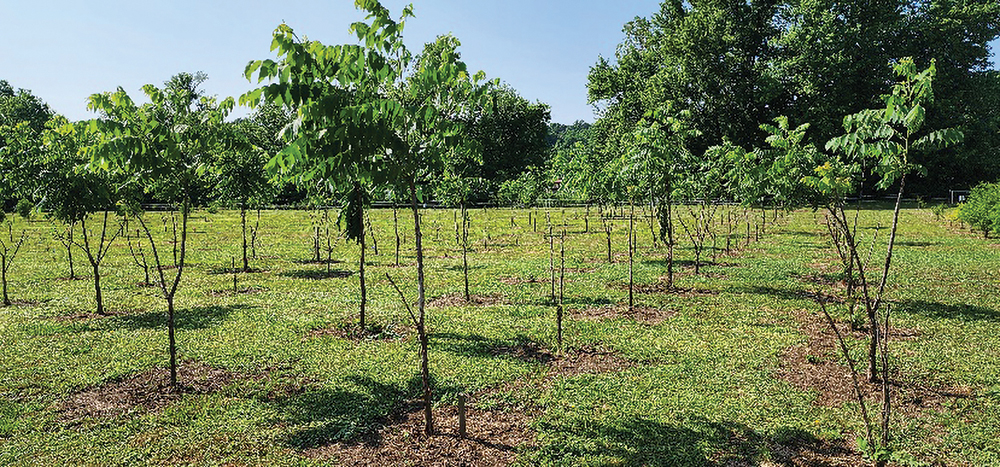
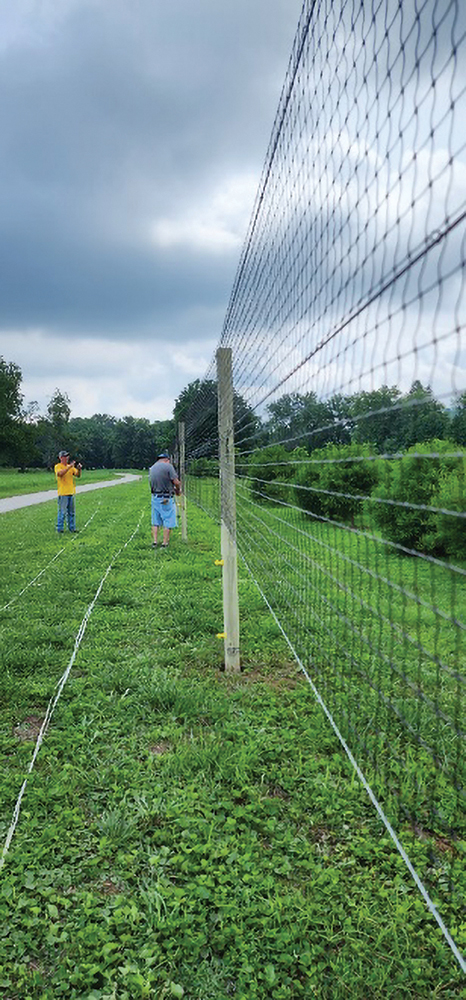
Year 1 Report
The direct cost of the initial planting and 3D deer exclusion fence was $2500, which the Walnut Council Foundation provided. The planting is two acres, and the fence is 1,500 feet long (Figure 5). The Johnson grass proved hard to kill, but multiple applications have reduced its presence in the plantation. The tall fescue has been easier to control. We use a glyphosate-based herbicide and Pendulum pre-emergent herbicide in our weed treatments. High water in the Ohio River, combined with a massive floating tree trunk, took down the 3D fence and the deer got in and browsed off the new white pine. The deer didn’t seem to bother the black walnut or bald cypress trainers. We did notice that there are good and bad growth areas in the plantation (Figure 6). Laboratory analyses of typical and minor elements in soil and tissue samples found no apparent differences among these sites, so the differences in growth we see remain a mystery. Despite the poor performance of white pine, both the bed run (wild) black walnut and the improved black walnuts averaged 2.1 feet in height. The bald cypress was amazing and averaged 3.2 feet by the end of the first growing season. The tallest of 270 black walnut seedlings in the plantation was a bed-run tree that was 4.9 feet tall.
Year 2 Report
We replanted the failed white pine and other voids. Another high water caused a small opening in the 3D fence, but it was quickly repaired with little deer browsing. Japanese hops (Humulus japonicus) invaded the plantation after the high water, leading us to believe its seeds floated in during the flood event (Figure 7); this aggressive plant threatened to completely envelop the young trees. Again, we used a glyphosate-based and a pre-emergent herbicide (in the form of Pendulum) to control these and other herbaceous weeds. During this year’s herbicide treatments, we used a hard water treatment (ammonium sulfate) in our tank mixes that seemed to improve the effectiveness of the herbicides. We measured the basal diameter and height of all the black walnuts in year two. The growth was impressive in some areas with both the improved and bed run black walnuts averaging 4.8 feet and 4.3 feet, respectively. The tallest black walnut in the plantation was a HTIRC #316 seedling that was 8.7 feet tall.
Year 3 Report
The replanted white pine from year two looked pitiful. After some research and advice, we found that white pine usually doesn’t survive above 6.5 pH. The soil pH measurements averaged 7.3. Further searching found other conifers that might grow well in the higher pH site.
This year we replanted the former white
pine planting locations with four conifer species: loblolly, short leaf, Virginia, and pitch×loblolly hybrid pines.
The 3D deer fence provides an optical bluff to deer. After two and a half years, the island’s deer herd called our bluff. They were reported by Park personnel to quickly jump over the 3D fence, which became utterly useless. In a week, they completely defoliated the black walnut as high as they could reach (Figure 8). We installed a 7.5-foot fence by adding 4 feet of plastic mesh above the 3D electric fence (Figure 9). As of three weeks following the new installation of high fencing, there has been no damage—the deer have withdrawn to plan their next attack.
Conclusion
It is way too early to answer the questions posed in the objective, but we have learned some hard lessons.
- Do the plot layout. Then kill sod-forming grasses before (not after) planting.
- Build an 8-foot-high deer fence at the outset. They can ruin the best experimental plan.
- Find someone who passes by the planting often and is willing to report problems.
- There are many candidate conifer trainers. Plant a mix, then replant with the winners.
The Organizations That Have Contributed to Make This Project Possible
The West Virginia Department of Natural Resources—State Park Service has not only provided the site, but also has been fully cooperative in the difficult logistics and maintenance of the planting area.
West Virginia University—Extension Service has provided guidance for the project and cost of the emergency high deer exclusion fence and a generous grant from Dr. Susan Dorsch.
A generous grant from the Walnut Council Foundation provided for the project’s initial direct expenses.
The Hardwood Tree Improvement and Regeneration Center provided the select black walnut crop tree seedlings.
The West Virginia Division of Forestry—Clements State Tree Nursery provided the trainer seedlings.
The U.S. Department of Agriculture—Natural Resource Conservation Service has provided site suitability testing and water table measurement.
The U.S. Forest Service has assisted with the project detailed experimental design.
Finally, many volunteers generously provided their time and effort to make the project plan become a reality.
















